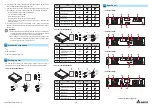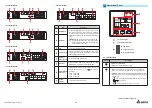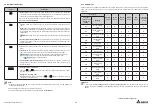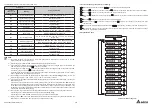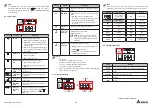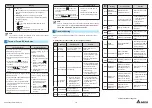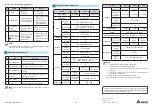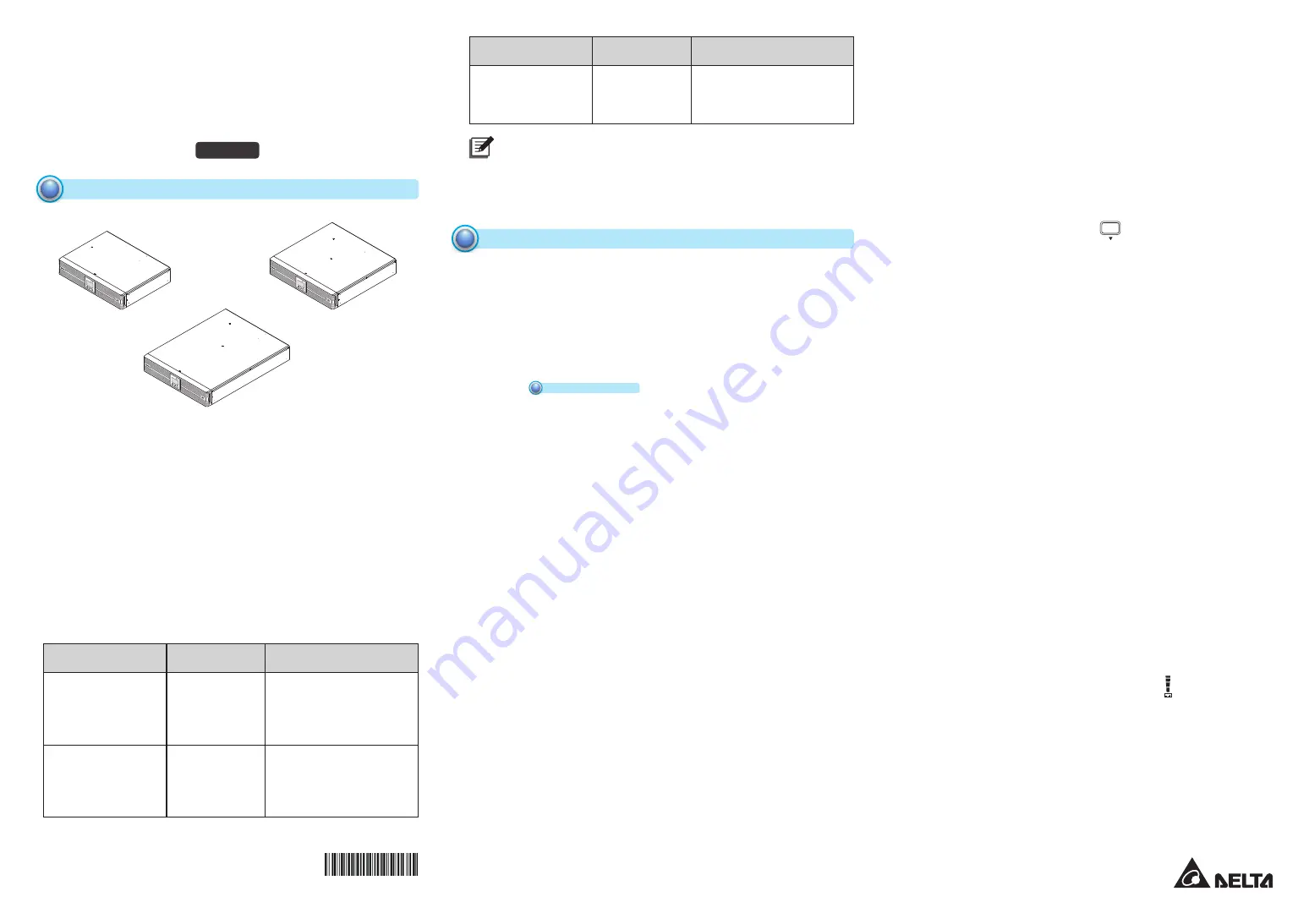
www.deltapowersolutions.com
1 / 8
Delta UPS - Amplon Family
R Series, Single Phase
1/ 2/ 3 kVA
Installation & Operation Quick Guide
ENGLISH
1
Product Introduction
ON
OFF
SET
UP
ON
OFF
SET
UP
ON
OFF
SET
UP
1kVA
2kVA
3kVA
The R series UPS, available in 1kVA, 2kVA and 3kVA, is a single-phase on-
line Uninterruptable Power Supply (UPS) system, which outputs reliable
sine wave power to your electrical equipment. The product is designed with
advanced technology and high quality components. Its output power factor
is up to 0.9, and efficiency in on-line mode reaches 93% (for 2kVA/ 3kVA).
The unit not only protects your electrical equipment by providing secure and
reliable uninterruptable power supply but also produces greater electric power
efficiency at less cost.
The Amplon Family R series UPS is a light, compact and easy to use solution
for IT applications and features rated nominal power capacities of 1kVA, 2kVA
and 3kVA. Each kVA model has internal batteries and each model can be
connected to the optional Delta external battery pack(s). The nominal rating
voltage of the internal batteries is 24V (1kVA), 48V (2kVA) and 72V (3kVA).
Please see the table below for details.
Model No.
Power Rating
Remarks
UPS102R2000B0B1
UPS102R2000B1B1
UPS102R2000B0B2
1kVA
With internal batteries (2
pcs 9Ah sealed lead-acid
batteries; battery voltage:
24Vdc)
UPS202R2000B0B1
UPS202R2000B1B1
UPS202R2000B0B2
2kVA
With internal batteries (4
pcs 9Ah sealed lead-acid
batteries; battery voltage:
48Vdc)
Model No.
Power Rating
Remarks
UPS302R2000B0B1
UPS302R2000B1B1
UPS302R2000B0B2
3kVA
With internal batteries (6 pcs
9Ah sealed lead-acid batteries;
battery voltage: 72Vdc)
NOTE:
1. The R Series UPS can connect to the optional Delta external battery
pack(s).
2. For more information about the optional Delta external battery pack(s),
please contact your dealer.
2
Safety Instructions
z
z
Placement and Installation
1. Read the Quick Guide carefully to ensure correct and safe usage of the
product.
2. Install the UPS in a well-ventilated area, away from rain, excess moisture,
dust, flammable gas or explosives.
3. To reduce the risk of fire or electric shock, install the UPS in a temperature
and humidity controlled indoor area free of conductive contaminants. Please
refer to
10
Technical Specifications
for operating temperature and relative
humidity.
4. Leave adequate space at least 15cm around each side of the UPS for proper
ventilation.
z
z
Connection warnings
1. Make sure the UPS is well grounded to avoid a possible risk of current
leakage.
2. The installation of protective devices (a DC non-fuse breaker or a DC fuse)
is highly recommended when the UPS is connected to the power source and
critical loads.
3. The protective devices connecting to the UPS must be installed near the UPS
and must be easily accessible for operation.
4. Do not use extension cord to connect the UPS to an AC outlet.
5. Do not plug the UPS input power cord into its own output receptacles.
6. Prior to moving or reconnecting the UPS, disconnect the AC input power and
ensure the UPS is powered off; otherwise, hazardous voltage may still exist
at the output receptacles of the UPS, which presents a possible risk of current
leakage.
7. Please ensure the length of the output power cord is shorter than 10m.
z
z
Usage warnings
1. The UPS is an EMC Class A product, which may cause wireless interference
in your living environment. Precautions need to be taken to prevent possible
interference.
2. The UPS can be used to power computers and associated peripheral devices,
such as monitors, modems, cartridge tape drives, external hard drives, etc.
3. It is strictly forbidden to connect the UPS to:
- regenerative loads
- loads with half-wave controlled rectifier circuit
- loads with asymmetrical current
4. The external slits and openings in the UPS are provided for ventilation.
To ensure reliable operation of the UPS and to protect the UPS from
overheating, these slits and openings must not be blocked or covered.
5. Before usage, you must allow the UPS to adjust to room temperature
(20°C~25°C) for at least one hour.
6. Do not splash any liquid on the UPS and be sure to prevent any foreign
material from dropping into the UPS. Do not put beverages on or nearby
the UPS.
7. In an emergency, hold and press the
OFF
button, and release it after you
hear one beep to turn off the UPS. Meanwhile, cut off the mains to shut
down the UPS.
8. Never use cleaning liquid or spray to clean the UPS. Before cleaning,
make sure you have (1) completely shut down the UPS, (2) unplugged the
UPS from the power outlet, and (3) disconnected the unit from the Delta
external battery pack(s).
9. Only qualified personnel can perform maintenance service. Do not open
or remove the covers or panels of the UPS to avoid high voltage electric
shock.
10.You must contact Delta customer service if either of the following events
occur:
- Liquid is poured or splashed on the UPS.
- The UPS does not run normally after carefully following the instructions
in this Quick Guide.
z
z
Battery Precautions
1. Do not dispose of the battery or batteries in a fire. The batteries may
explode. Do not open or damage the battery or batteries. The released
electrolyte is harmful to the skin and eyes and may be toxic.
2. Servicing batteries and battery packs should be performed or supervised
by qualified service personnel who are knowledgeable in batteries, battery
packs and the required precautions.
3. The risk of dangerous voltage is possible when the batteries are still
connected to the UPS even though the UPS is disconnected from the
mains. Do not forget to disconnect the battery cable to completely cut off
the battery source.
4. To ensure battery performance, idle batteries must be fully recharged
every three month if the UPS needs to be stored for an extended period of
time. Whenever you recharge the batteries (internal and external), please
fully charge them until the Battery Level Bar Graph shown on the UPS’s
LCD is fully on.
5. Since new batteries often do not provide full capacity after an initial
charge, it may be necessary to carry out a number of discharge/ recharge
cycles before optimum performance is achieved.
Continue to the Next Page
5013252501


